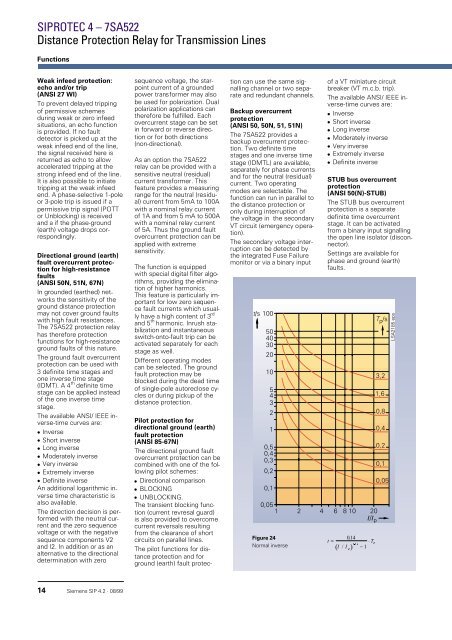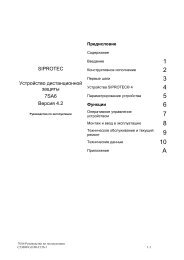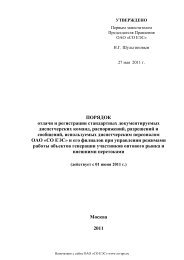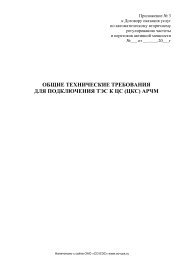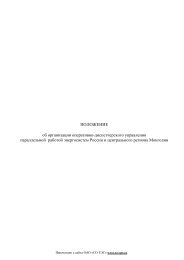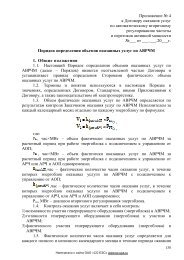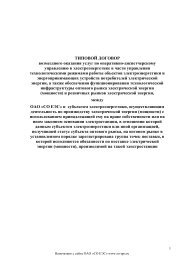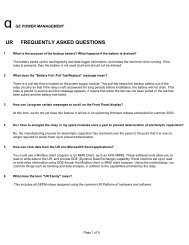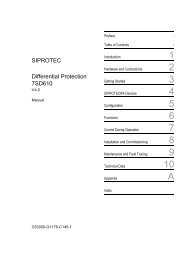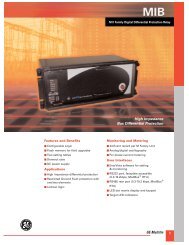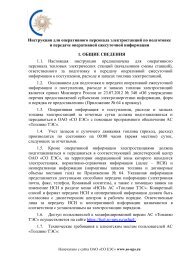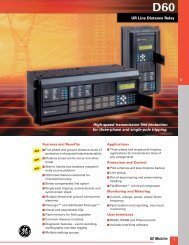SIPROTEC 4 7SA522 Distance Protection Relay for Transmission ...
SIPROTEC 4 7SA522 Distance Protection Relay for Transmission ...
SIPROTEC 4 7SA522 Distance Protection Relay for Transmission ...
You also want an ePaper? Increase the reach of your titles
YUMPU automatically turns print PDFs into web optimized ePapers that Google loves.
<strong>SIPROTEC</strong> 4 – <strong>7SA522</strong><br />
<strong>Distance</strong> <strong>Protection</strong> <strong>Relay</strong> <strong>for</strong> <strong>Transmission</strong> Lines<br />
Functions<br />
Weak infeed protection:<br />
echo and/or trip<br />
(ANSI 27 WI)<br />
To prevent delayed tripping<br />
of permissive schemes<br />
during weak or zero infeed<br />
situations, an echo function<br />
is provided. If no fault<br />
detector is picked up at the<br />
weak infeed end of the line,<br />
the signal received here is<br />
returned as echo to allow<br />
accelerated tripping at the<br />
strong infeed end of the line.<br />
It is also possible to initiate<br />
tripping at the weak infeed<br />
end. A phase-selective 1-pole<br />
or 3-pole trip is issued if a<br />
permissive trip signal (POTT<br />
or Unblocking) is received<br />
and a if the phase-ground<br />
(earth) voltage drops correspondingly.<br />
Directional ground (earth)<br />
fault overcurrent protection<br />
<strong>for</strong> high-resistance<br />
faults<br />
(ANSI 50N, 51N, 67N)<br />
In grounded (earthed) networks<br />
the sensitivity of the<br />
ground distance protection<br />
may not cover ground faults<br />
with high fault resistances.<br />
The <strong>7SA522</strong> protection relay<br />
has there<strong>for</strong>e protection<br />
functions <strong>for</strong> high-resistance<br />
ground faults of this nature.<br />
The ground fault overcurrent<br />
protection can be used with<br />
3 definite time stages and<br />
one inverse time stage<br />
(IDMT). A 4 th definite time<br />
stage can be applied instead<br />
of the one inverse time<br />
stage.<br />
The available ANSI/ IEEE inverse-time<br />
curves are:<br />
• Inverse<br />
• Short inverse<br />
• Long inverse<br />
• Moderately inverse<br />
• Very inverse<br />
• Extremely inverse<br />
• Definite inverse<br />
An additional logarithmic inverse<br />
time characteristic is<br />
also available.<br />
The direction decision is per<strong>for</strong>med<br />
with the neutral current<br />
and the zero sequence<br />
voltage or with the negative<br />
sequence components V2<br />
and I2. In addition or as an<br />
alternative to the directional<br />
determination with zero<br />
sequence voltage, the starpoint<br />
current of a grounded<br />
power trans<strong>for</strong>mer may also<br />
be used <strong>for</strong> polarization. Dual<br />
polarization applications can<br />
there<strong>for</strong>e be fulfilled. Each<br />
overcurrent stage can be set<br />
in <strong>for</strong>ward or reverse direction<br />
or <strong>for</strong> both directions<br />
(non-directional).<br />
As an option the <strong>7SA522</strong><br />
relay can be provided with a<br />
sensitive neutral (residual)<br />
current trans<strong>for</strong>mer. This<br />
feature provides a measuring<br />
range <strong>for</strong> the neutral (residual)<br />
current from 5mA to 100A<br />
with a nominal relay current<br />
of 1A and from 5 mA to 500A<br />
with a nominal relay current<br />
of 5A. Thus the ground fault<br />
overcurrent protection can be<br />
applied with extreme<br />
sensitivity.<br />
The function is equipped<br />
with special digital filter algorithms,<br />
providing the elimination<br />
of higher harmonics.<br />
This feature is particularly important<br />
<strong>for</strong> low zero sequence<br />
fault currents which usually<br />
have a high content of 3 rd<br />
and 5 th harmonic. Inrush stabilization<br />
and instantaneous<br />
switch-onto-fault trip can be<br />
activated separately <strong>for</strong> each<br />
stage as well.<br />
Different operating modes<br />
can be selected. The ground<br />
fault protection may be<br />
blocked during the dead time<br />
of single-pole autoreclose cycles<br />
or during pickup of the<br />
distance protection.<br />
Pilot protection <strong>for</strong><br />
directional ground (earth)<br />
fault protection<br />
(ANSI 85-67N)<br />
The directional ground fault<br />
overcurrent protection can be<br />
combined with one of the following<br />
pilot schemes:<br />
• Directional comparison<br />
• BLOCKING<br />
• UNBLOCKING.<br />
The transient blocking function<br />
(current revresal guard)<br />
is also provided to overcome<br />
current reversals resulting<br />
from the clearance of short<br />
circuits on parallel lines.<br />
The pilot functions <strong>for</strong> distance<br />
protection and <strong>for</strong><br />
ground (earth) fault protection<br />
can use the same signalling<br />
channel or two separate<br />
and redundant channels.<br />
Backup overcurrent<br />
protection<br />
(ANSI 50, 50N, 51, 51N)<br />
The <strong>7SA522</strong> provides a<br />
backup overcurrent protection.<br />
Two definite time<br />
stages and one inverse time<br />
stage (IDMTL) are available,<br />
separately <strong>for</strong> phase currents<br />
and <strong>for</strong> the neutral (residual)<br />
current. Two operating<br />
modes are selectable. The<br />
function can run in parallel to<br />
the distance protection or<br />
only during interruption of<br />
the voltage in the secondary<br />
VT circuit (emergency operation).<br />
The secondary voltage interruption<br />
can be detected by<br />
the integrated Fuse Failure<br />
monitor or via a binary input<br />
Figure 24<br />
Normal inverse<br />
of a VT miniature circuit<br />
breaker (VT m.c.b. trip).<br />
The available ANSI/ IEEE inverse-time<br />
curves are:<br />
• Inverse<br />
• Short inverse<br />
• Long inverse<br />
• Moderately inverse<br />
• Very inverse<br />
• Extremely inverse<br />
• Definite inverse<br />
STUB bus overcurrent<br />
protection<br />
(ANSI 50(N)-STUB)<br />
The STUB bus overcurrent<br />
protection is a separate<br />
definite time overcurrent<br />
stage. It can be activated<br />
from a binary input signalling<br />
the open line isolator (disconnector).<br />
Settings are available <strong>for</strong><br />
phase and ground (earth)<br />
faults.<br />
t =<br />
( I / I<br />
P)<br />
014 .<br />
⋅ T<br />
002 .<br />
P<br />
− 1<br />
14 Siemens SIP 4.2 · 08/99


